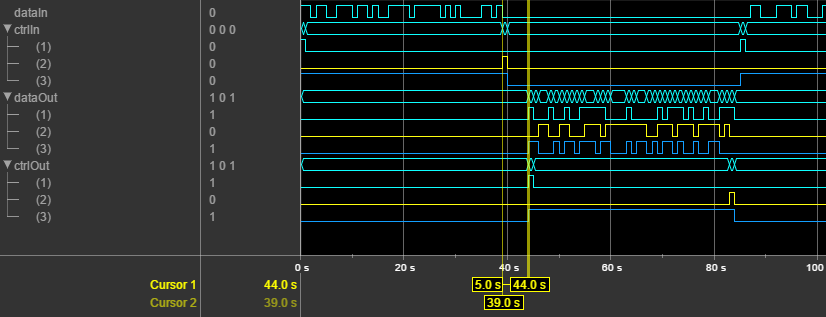LTE Convolutional Encoder
Encode binary samples using tail-biting convolutional algorithm
Libraries:
Wireless HDL Toolbox /
Error Detection and Correction
Description
The LTE Convolutional Encoder block implements the encoding polynomials specified by LTE standard TS 36.212 [1]. The convolutional code has constraint length 7 and is tail biting with coding rate 1/3 and octal polynomials G0=133, G1=171 and G2=165. The block provides a hardware-optimized architecture and interface.
This block uses a
streaming sample interface with a bus for related control signals. This interface enables the
block to operate independently of frame size, and to connect easily with other Wireless HDL Toolbox™ blocks. The block accepts and returns a value representing a single sample, and a
bus containing three control signals. These signals indicate the validity of each sample and the
boundaries of the frame. To convert a matrix into a sample stream and these control signals, use
the Frame To Samples block
or the whdlFramesToSamples
function. For a full description of the interface, see Streaming Sample Interface.
The message size can change dynamically. The encoded output bits for each input bit
are returned as a 3-by-1 vector, [G0 G1 G2].
The block takes M + 5 cycles to encode a frame of
M samples. Therefore, you must leave M + 5
idle cycles between input frames. Alternatively, you can use the output signal
ctrl.end to determine when the block is
ready for new input.
This waveform shows an input message of 40 samples, with 45 idle cycles between
frames. The output data is a vector of three encoded bits. The input and output
ctrl buses are expanded to show the control signals.
start and end show the frame boundaries, and
valid qualifies the data samples.

Examples
Ports
Input
Output
Parameters
Tips
You cannot use this block inside an Enabled Subsystem or Resettable Subsystem.
Algorithms
References
[1] 3GPP TS 36.212. "Multiplexing and channel coding." 3rd Generation Partnership Project; Technical Specification Group Radio Access Network; Evolved Universal Terrestrial Radio Access (E-UTRA). URL: https://www.3gpp.org.
Extended Capabilities
Version History
Introduced in R2017b

